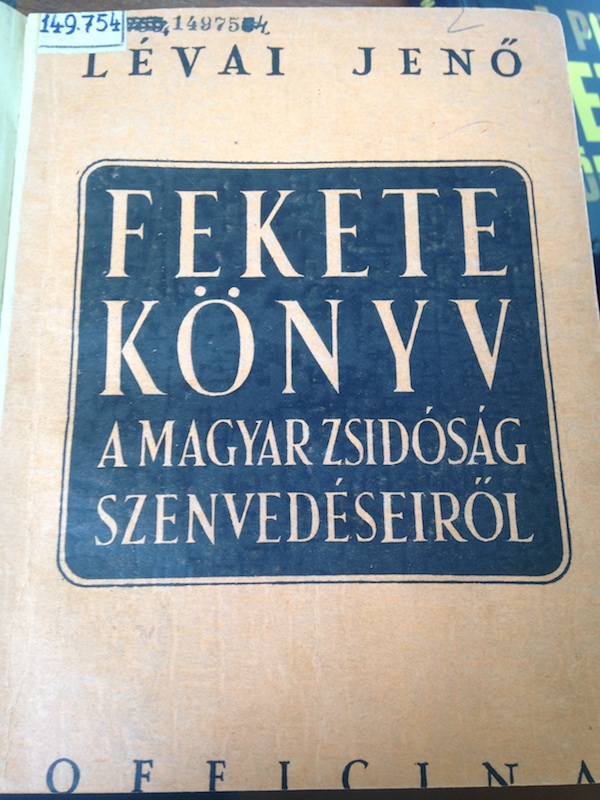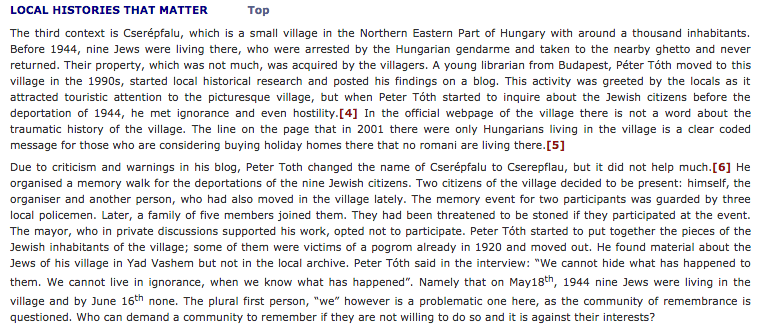Kutatótársammal szoktunk levelezni is. Itt egy levélváltás kivonata:
Tóth Péter: Olvasom ezt a tiltakozó jegyzékes hírt, nemrég láttam a lengyel Ida című filmet, amiben szinte nem is esik szó a németekről Hogy lehet erről a témáról mégis normálisan beszélni? Arról, hogy nem csak és kizárólag a nácik itt a bűnösök?
Hogyan lehet azt elmondani és kijelenteni általánosítás nélkül, hogy igenis baromi sokan voltak akik tevékeny részeseivé voltak a borzalomnak Cserépfaluban, Mezőkövesden, Budapesten és szinte mindenhol Magyarországon. Akik csak elfordították a fejüket, amikor pakolták ki Groszmannékat. Ők is részesei voltak. Mi lett volna vajon ha Cserépfaluban is elbújtatják a gyerekeket nem csak Noszvajon?
2. Groszmann Lili nap május 24-én Cserépfaluból Mezőkövesdig.
Túlzott naivitás és idealizmusos baromság részemről ez az egész most 2015-ben? Akkor volt egy durva háború, küzdeni kellett kajáért mindenért, mindenki a magáét védte, de akkor sem. Akkor is voltak akik cselekedtek.
Valahol olvastam, hogy azért kutatunk hogy megértsük a mát amiből lesz a jövő. és ha a mai magyarországi viszonyokat nézzük, főle a sok szélsőjobbos kretént, azért ez a téma, történet nincs egyáltalán kibeszélve.
na mindegy
Balázs István: Nos… nyugodt szívvel kijelenthetjük, hogy a magyar közigazgatás igenis tevékenyen részt vett a holokausztban.
Azt is kijelenthetjük, hogy a polgárok egy része hasznot húzott a holokausztból.
Azt is kijelenthetjük, hogy az egyházak egy része is hasznot húzott a holokausztból.
Azt is kijelenthetjük, hogy a Levente Mozgalom is hasznot húzott a holokausztból.
Azt is kijelenthetjük, hogy az iparosok zöme is hasznot húzott a holokausztból.
Azt is kijelenthetjük, hogy Magyarországon érkezett a legtöbb bejelentés a zsidókról Eichmannékhoz.
Azt is kijelenthetjük, hogy itt igényelte a legtöbb magánember a zsidó vagyon egy részét.
Azt is kijelenthetjük, hogy itt érte a legtöbb atrocitás a zsidókat Lengyelország után.
Azt is kijelenthetjük, hogy innen deportálták a leggyorsabban a zsidókat a holokauszt alatt.
Azt is kijelenthetjük, hogy 1945 után is az antiszemita látásmód volt jellemző Magyarországra.
Azt is kijelenthetjük, hogy 1956-ban pogromokat szerveztek…..
Kijelenthetjük-e, hogy nem vett részt tevékenyen a magyar nép a holokausztban ennek tükrében? Vagy foghatjuk-e csak a németekre ennek tükrében?
TP: Na hát ez az pontosan! csak a magyar nép nevű két szót a végén lehet általánosításként értelmezni? Szerintem nem. Mert írod hogy: egy része, meg azt is, hogy zöme több helyen is
Aztán a végén ezzzel fejezed be: Kijelenthetjük-e, hogy nem vett részt tevékenyen a magyar nép a holokausztban ennek tükrében?
BL: Nem választhatjuk szét azokat, akik aktívan részt vettek, illetve azokat, akik passzivitásukkal vettek részt az eseményekben. Tehát igazából nem mondhatjuk azt, hogy nem a magyar nemzet bűne, csak csoportoké….
TP: Szerintem sem lehet szétválasztani, nem is kell, de nem volt mindenki passzív! Mi van azokkal akik védelmet adtak? Bújtattak, etettek stb, Ők csak egy hibajelenség voltak az egész kibaszott pusztításban? Attól még ment minden tovább.
BI: Nem hibajelenség voltak, felülkerekedett a humánum az esztelenségen.
TP: Ha bocsánatot kér a holokausztért egy állami képviselője vagy akár mi vagy akár én, akkor az egész nép nevében kérünk, kérhetek bocsánatot? Általánosíthatok? Beismerés az általánosítás?
Itt van két hír, hogy a szerbekért és a romákért Áder elnök bocsánatot kért.
BI: Szerintem nem a bocsánatkérésen múlik. A mutatott tetteken és a hozzáálláson 🙂 Ha leköpök valakit és azt mondom, bocs, de belül ugyanúgy leköpném újra….?
TP: Persze, hogy nem azon múlik Csak azon moralizálok, hogy egy nép nevében nyilatkozhatunk-e Ha igen, akkor beismertük.
BI: Szerintem döntse el az egyén, ne más nevében tegye….
TP: Adj valami olvasnivalót ez a lengyel Ida elég durván belémvágott hétvégén
BI: Lévai Jenő: Fekete könyv, és ugyancsak tőle a Pesti gettó története.


